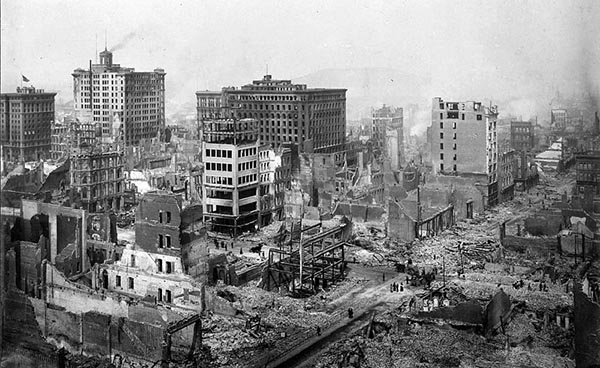The San Francisco earthquake of 1906 is one of the most infamous natural disasters in United States history. How has it compared with earthquakes worldwide?
When the subject is “America’s Worst Disasters,” the San Francisco earthquake of 1906 likely is among the topics. Approximately 3,000 people died, some 25,000 buildings were destroyed, almost 500 city blocks were ruined, $524 million in damage resulted (many billions, in today’s currency) and the survivors were in shock for days and weeks to come.
As time passes and modern-day floods, fires, hurricanes and other events create new catastrophic sensations, the San Francisco ordeal is remembered less frequently. The tragedy still ranks, however, among the worst natural disasters in United States history.
How does it compare with earthquakes that have occurred worldwide during the past century?
One of a String of Seismic Events in 1906
Simon Winchester, author of A Crack in the Edge of the World, pointed out that the San Francisco disaster was one of a series of seismic events that occurred within a very short time period. An underwater earthquake centered off South America on 31 January 1906 is believed to have been the strongest recorded until that time. Casualties may have reached 2,000, and large waves were pushed onshore as far off as Hawaii and California.
In February, a strong undersea earthquake rocked the islands of St. Lucia and Martinique in the Caribbean.
More than a thousand people perished in March when another underwater quake left a fissure nine miles long on the West Pacific island of Formosa (Taiwan).
On 6 April, classic volcano Mt. Vesuvius in Italy gave one of its historic horror displays. (This time, “only” 150 people died.)
Then came Wednesday, 18 April 1906.
A Minute to Tremble, Years to Recover
The city of San Francisco began to shake at 5:12 in the morning. The earthquake—its epicenter on the San Andreas Fault two miles into the Pacific—lasted just one minute. The havoc wrought would have an impact on the area for decades.
Homes and brick buildings collapsed. Pavements buckled. Trees crashed to the ground. Roads, streets and streetcar tracks were severed.
Then came the fires, which burned out of control several days. They could not be contained because essential pipelines bringing water into the city were broken.
In terms of human carnage, the greatest danger was collapsing chimneys. An estimated 95 percent of the city’s chimneys toppled, and people beneath them had no warning of the cascading brick missiles. San Francisco Fire Chief Dennis Sullivan was one such victim.
Comparative Statistics
The 1906 San Francisco earthquake, despite its immediate horrors and long-term miseries, was not among the worst quakes of all time in terms of either casualties or property damage. Nor was it one of the strongest.
It’s estimated to have been a magnitude 7.8 quake. The most powerful on record was the Chilean earthquake of May 1960, magnitude 9.5. (Interestingly, only half as many lives were lost in Chile as in crowded San Francisco.)
While the 3,000 fatalities in San Francisco were heart-wrenching, the number pales in comparison to earthquake deaths in Tangshan, China, in July 1976 (255,000); Sumatra in December 2004 (228,000); Haiti in January 2010 (222,000); and many others during the past hundred years.
The U.S. Geological Survey terms the 1906 San Francisco quake as “one of the most devastating in the history of California.” (Endnote: A far worse event occurred in August the same year: A massive earthquake killed some 20,000 people in and near Valparaiso, Chile.)
To keep up to date on earthquakes reported around the globe, visit the U.S. Geological Survey’s page “Latest Earthquakes in the World—Past 7 Days.”
Sources:
- “Historic Earthquakes: San Francisco, California, 1906. . . .” U.S. Geological Survey Web site.
- “Largest Earthquakes in the World Since 1900.” U.S. Geological Survey Web site.
- Winchester, Simon. A Crack in the Edge of the World: America and the Great California Earthquake of 1906. HarperCollins Publishers (2005).








